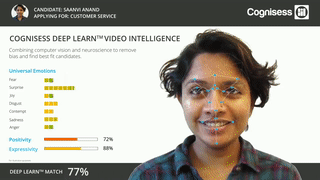The coronavirus is affecting the way we hire. Many HR recruiters are now working remotely and are reaping the benefits of video interviews. In fact, 67% of companies are now using video interviews to hire workers according to the recruitment company, Walters People.
In this blog, we will explore how to successfully conduct a video interview and the differences between face to face and video interviews.
How to set up a video interview
This interview may be a candidate’s first verbal interaction with your company. Here’s how to make a great first impression.
Pick a suitable environment
Select a room which will be quiet and free of disruptions. Once you find a place, look behind you, this is what the candidate will see during the interview, remove anything you wouldn’t want the candidate to see.
Additionally, choose a place in the house where you have a strong internet connection. Lag, video freezes or the call dropping will disrupt the interview.
Test your webcam and microphone
If your webcam isn’t built-in, place it on top of your screen so you’re eye level with the applicant. Most video call providers allow you to test your webcam before a call. In this mode, ensure that you can see your whole face and check if there is light obscuring it.
It’s also important to test the audio. If you wear headphones check if they have a microphone, otherwise the applicant won’t be able to hear you.
Why video interviews are different
Technical difficulties
This study found that interviewees who have technical difficulties are often perceived poorly by the assessor. This means the best candidates may not get hired due to a bad internet signal. Instead, ask the candidates to record their answers to give everyone a fair chance and eliminate the possibility of a great answer being ruined by the call dropping.
Lack of non-verbal communication
Many interviewers may say they have a good gut instinct. Gut feeling is a great resource, but it is the imperfect and human equivalent of processing lots of data (such as the applicant’s body language and communication) and coming to a conclusion. However, a lot of these decision-making factors disappear in a video interview.
Researchers at the George Washington University “analyzed 12 studies on technology and job interviews published between 2000 and 2007 and believe that the absence of body language, eye contact and rapport building in video interviews can hurt a person’s chance of landing the job.” For example, you may not be able to read someone’s body language if the screen only shows part of their face.
This may seem problematic, but by using technology to enhance your decision making and assist you with these potential ‘blind spots’ will allow you to hire the most suitable candidates.
The solution: Cognisess’ Video Analysis

By using our DeepLearnTM Video Analysis tool our technology will be able to detect a candidate’s true emotion, instead of what they may like to present to an interview panel.
Each candidate records themselves answering several key questions that have been set by the company. Our Computer Vision technology is then able to analyse from 27+ points on the face, searching for emotions such as positivity alongside other attributes relevant to the job frame by frame.
As Cognisess Pro isn’t human, so it has the capacity to be completely objective (read our blog on unconscious bias in humans here). As there isn’t any human involvement in the analysis process, it supports a less bias hiring decision. Our tool isn’t programmed to see race, age or gender – it is purely assessing what an applicant is non-verbally communicating. This becomes a vital tool when companies are pursuing policies of inclusion, diversity and fairness.
A sample of the emotions the tool can identify

- Confidence and control. When customers are interacting with your business, they want to talk to someone who is in control of a situation and confident in their abilities. You can now measure this before you hire an applicant.
- Positivity. An upbeat employee not only improves morale in the workplace but their positive nature will help them successfully communicate with clients. For example, if a client sees a sales executive who is sincerely positive about a product, they are more likely to buy it.
- Expressiveness. Some people make everyone they talk to feel like they are being truly listened to. A high level of expression (within reason) is seen in western cultures as a sign of high levels of engagement in the subject of the conversation.
- Resilience and grit. This allows a person to maintain the discipline and optimism to persevere, despite rejection and a lack of noticeable process over a period of time.
As a result, HR professionals can draw conclusions from their expertise and the data presented to them. They can listen to the content of the answer (verbal communication) as well as understanding how candidates are feeling (non-verbal communication).
Technology can help us navigate through the rapidly changing world of work. Using our video analysis tool will allow you to hire confidently and remotely. Knowing that you’ve given every candidate a fair chance, whilst finding the best fit for your company. Book a free demo today to explore how you can enhance your video interview process.


